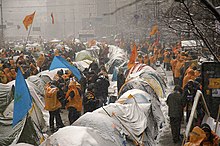2005–2006 Russia–Ukraine gas dispute
The conflict started in March 2005, ended in January 2006 and, in addition to the gas companies, involved politicians from both countries.
Ukrainian officials at first denied the last accusation,[1][2] but later Naftogaz admitted it used some gas intended for other European countries for domestic needs.
[4] Gas trading was conducted under bilateral intergovernmental agreements providing a framework for sales, transit volumes and prices and sometimes other issues such as storage and establishment of joint production ventures.
The relevant companies signed contracts in accord with the agreements, supplemented by annual refinements specifying exact prices and volumes for the following year.
RosUkrEnergo beneficiaries include well-placed officials in Russian and Ukrainian gas industries and governmental structures.
[9] The Ukrainian investigation into RosUkrEnergo, during Yulia Tymoshenko's previous term as prime minister, was closed after Yushchenko fired her in September 2005.
[10] According to the contract between Gazprom and Naftogaz signed on June 21, 2002, payment was in the form of barter—up to 15% of gas pumped through the Ukrainian territory was taken by Ukraine instead of cash.
[12][13] On August 9, 2004, the two companies signed a contract addendum setting the transit tariff at US$1.09 per 1,000 cubic meters per 100 kilometres (62 mi).
[14] In 2005, Gazprom argued that this addendum was only applicable provided that the two countries sign an annual intergovernmental protocol having higher legal status for specifying the terms of gas transit.
[18] In March, Gazprom informed Ukraine that it was raising prices to market levels, charging $160 per 1,000 cubic meters (approximately $4.40 per million Btu).
[30] On December 15, Ukraine offered a joint-venture for selling gas in the internal Ukrainian market in exchange for gradual price increases up to 2010.
[31] On December 26, Prime Minister Yuriy Yekhanurov asserted that Ukraine had a contractual right for 15% of the gas transiting to the European Union.
[32] This statement came largely in response to the Gazprom threat to resort to the Arbitration Institute of the Stockholm Chamber of Commerce should Ukraine engage in unlawful withdrawal of Russian transit gas.
[36] On January 1, 2006 Gazprom started reducing pressure in the pipeline system ahead of the deadline of the Russian ultimatum set for 10:00 MSK.
Gazprom invited the Switzerland-based goods inspection and testing company SGS to monitor the amount of gas that is entering Ukraine's pipeline network.
After mixing it with two thirds of cheaper supplies from Central Asia RosUkrEnergo resold it to Ukraine at a price of $95 per 1,000 cubic metres.
[50] On January 3 Russian Prime Minister Mikhail Fradkov asked the European Union to influence Ukraine to ensure gas transit from Russia to EU countries.
[51] On January 3 and 4 Austrian Minister of Foreign Affairs Ursula Plassnik supported resumption of gas supplies by Gazprom and emphasized that a lasting solution was preferable to unilateral measures.
[52][53] According to Pascal Lamy of the World Trade Organization, all Post-Soviet states that buy gas from Gazprom should pay market prices to improve the efficiency of their economies.



